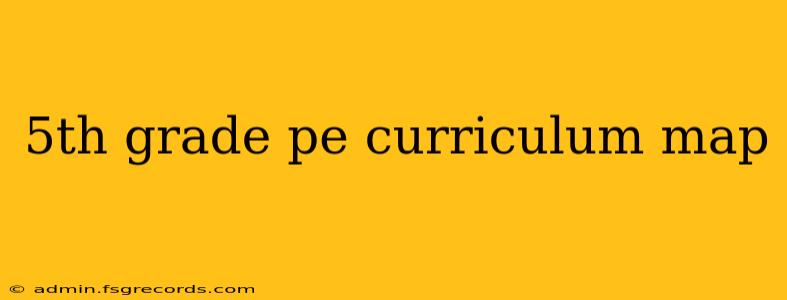This 5th-grade PE curriculum map provides a detailed framework for educators to design engaging and developmentally appropriate physical education lessons throughout the school year. It focuses on building fundamental movement skills, promoting healthy lifestyles, and fostering teamwork and sportsmanship. This map is adaptable to various school settings and can be modified to meet the specific needs of your students.
First Quarter: Foundations of Fitness & Fundamental Movement Skills
This quarter emphasizes building a strong foundation in fundamental movement skills and introducing basic fitness concepts.
Unit 1: Movement Exploration & Fitness Assessments (3 Weeks)
- Learning Objectives: Students will be able to identify and demonstrate locomotor and non-locomotor movements; understand basic fitness components (cardiovascular endurance, muscular strength, flexibility); and participate safely in fitness assessments.
- Activities: Movement exploration games, obstacle courses, basic fitness assessments (e.g., sit-and-reach, pacer test, push-ups/modified push-ups).
- Assessment: Observation of movement skills, participation in fitness assessments, completion of fitness logs.
Unit 2: Developing Locomotor Skills (4 Weeks)
- Learning Objectives: Students will refine their running, jumping, hopping, skipping, and leaping skills; improve coordination and balance; understand the importance of proper technique.
- Activities: Relay races, jump rope activities, agility drills, creative movement challenges incorporating locomotor skills.
- Assessment: Skill demonstrations, participation in games and activities, peer and self-assessment of skill development.
Unit 3: Introducing Non-Locomotor & Manipulative Skills (3 Weeks)
- Learning Objectives: Students will learn and practice various non-locomotor skills (bending, twisting, stretching); develop manipulative skills (throwing, catching, striking, kicking); and understand the importance of proper form and safety.
- Activities: Stretching exercises, yoga poses, throwing and catching games, striking activities (e.g., hitting a ball with a bat or paddle), kicking games.
- Assessment: Skill demonstrations, participation in games, self-assessment of skill improvement.
Second Quarter: Team Sports & Cooperative Games
This quarter focuses on developing teamwork, cooperation, and sportsmanship through team sports and cooperative games.
Unit 4: Team Handball & Cooperative Games (4 Weeks)
- Learning Objectives: Students will learn the rules and strategies of team handball; develop teamwork and communication skills; practice sportsmanship; participate in various cooperative games emphasizing collaboration and problem-solving.
- Activities: Team handball games, modified rules to accommodate skill levels, cooperative games focusing on problem-solving and teamwork.
- Assessment: Participation in games, demonstration of understanding of rules and strategies, observation of teamwork and sportsmanship.
Unit 5: Basketball Fundamentals (4 Weeks)
- Learning Objectives: Students will learn basic basketball skills (dribbling, passing, shooting); understand basic basketball rules and strategies; work effectively as a team; demonstrate sportsmanship.
- Activities: Dribbling drills, passing drills, shooting practice, small-sided basketball games.
- Assessment: Skill demonstrations, participation in games, understanding of rules and strategies, display of sportsmanship.
Unit 6: Soccer Fundamentals (3 Weeks)
- Learning Objectives: Students will learn basic soccer skills (dribbling, passing, shooting, trapping); understand basic soccer rules and strategies; develop teamwork and communication skills; practice sportsmanship.
- Activities: Dribbling drills, passing drills, shooting practice, small-sided soccer games.
- Assessment: Skill demonstrations, participation in games, understanding of rules and strategies, display of sportsmanship.
Third Quarter: Fitness & Rhythmic Activities
This quarter focuses on improving fitness levels and exploring rhythmic activities.
Unit 7: Cardiovascular Fitness & Endurance Activities (4 Weeks)
- Learning Objectives: Students will participate in various cardiovascular activities to improve endurance; understand the importance of regular physical activity; monitor heart rate and understand target heart rate zones.
- Activities: Running, jogging, skipping, jumping jacks, dance routines, fitness circuits.
- Assessment: Participation in activities, monitoring of heart rate, self-assessment of fitness levels.
Unit 8: Rhythmic Activities & Dance (4 Weeks)
- Learning Objectives: Students will explore various rhythmic movements and dance forms; develop coordination, creativity, and expression; understand the connection between music and movement.
- Activities: Creative movement, dance routines, folk dances, line dancing.
- Assessment: Participation in activities, demonstration of rhythmic skills, creativity in movement.
Unit 9: Strength Training & Flexibility (3 Weeks)
- Learning Objectives: Students will learn and practice bodyweight exercises to improve muscular strength; engage in stretching exercises to improve flexibility; understand the importance of proper form and safety.
- Activities: Bodyweight exercises (push-ups, squats, lunges), stretching exercises (yoga, static stretches), flexibility assessments.
- Assessment: Skill demonstrations, participation in activities, self-assessment of strength and flexibility.
Fourth Quarter: Outdoor Activities & Review
This quarter focuses on outdoor activities and reviewing skills learned throughout the year.
Unit 10: Outdoor Games & Activities (4 Weeks)
- Learning Objectives: Students will participate in various outdoor games and activities; develop cooperation, leadership, and problem-solving skills; appreciate the benefits of outdoor play.
- Activities: Kickball, capture the flag, ultimate frisbee, nature walks, outdoor fitness challenges.
- Assessment: Participation in activities, demonstration of cooperation and leadership, self-assessment of skill improvement.
Unit 11: Skills Review & Fitness Challenges (4 Weeks)
- Learning Objectives: Students will review and refine previously learned skills; participate in fitness challenges; set personal fitness goals.
- Activities: Skill stations, fitness challenges, obstacle courses, games incorporating previously learned skills.
- Assessment: Skill demonstrations, participation in challenges, reflection on progress and goal setting.
This curriculum map provides a flexible framework. Adjust the timing of units and activities based on your students' needs and available resources. Remember to prioritize safety, fun, and a positive learning environment throughout the year.

